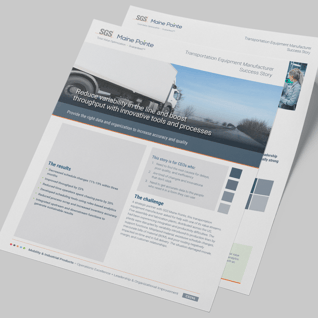Reducing variability in the line and boost throughput with innovative tools and processes (CS296)
This story is for CEOs who:
- Need to find the root causes for delays, poor quality, and inefficiency
- Are tired of changes and innovations that don’t stick
- Need to get accurate data to the people who need it in a form they can use
The Challenge
A strategic partner with SGS Maine Pointe, this transportation equipment manufacturer asked for help with one of its value streams. Five assembly and fabrication plants, distributed across the US, had been experiencing integration and productivity difficulties. The plants were disrupted by variability introduced to production lines by support functions. Misplaced material, excessive schedule changes, inaccurate bills of material (BOM), and poor routing negatively impacted on-time and in full delivery. The situation damaged morale, margin, and customer relationships.
Initiating sustainable innovations that bring scheduling, routing, and change orders under control
SGS Maine Pointe:
- Implemented a 28-week, nine-stage-gate process to test innovations, identify the best choices, and create ownership
- Secured the benefits of cross-functional teams in a formerly siloed organization
- Developed custom ETA Confidence, ETA Quality, and Production Slotting tools and a materials availability process
- Enhanced the truck body tracking system and rolled-out granular routing
- Integrated information flow and service-level agreement (SLA) across the plants
- Improved the accuracy of bills of material to ensure parts were used as designed
- Standardized the sales order process, including change orders
Lessons learned for other executives
- After data analytics reveal root causes, hands-on training and teamwork ensure that solutions stick
- The right tools in the hands of the right people increase efficiency, throughput, and safety
The Results
- Decreased schedule changes 11%-19% within three months
- Improved throughput by 23%
- Reduced time operators spent chasing parts by 20%
- Developed scheduling tools using rules-based analytics
- Reduced process scrap and increased inventory accuracy
- Integrated upstream and downstream functions to generate sustainable results
×
Reduce variability in the line and boost throughput with innovative tools and processes (CS296)


